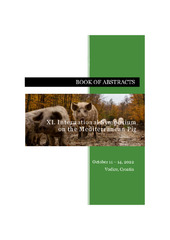Приказ основних података о документу
Carcass traits of Mangalitsa pigs - effect of immunocastration
| dc.creator | Savić, Radomir | |
| dc.creator | Radojković, Dragan | |
| dc.creator | Gogić, Marija | |
| dc.creator | Stojiljković, Nenad | |
| dc.creator | Živković, Vladimir | |
| dc.creator | Petrović, Aleksandra | |
| dc.creator | Radović, Čedomir | |
| dc.date.accessioned | 2023-01-09T07:48:26Z | |
| dc.date.available | 2023-01-09T07:48:26Z | |
| dc.date.issued | 2022-10-11 | |
| dc.identifier.isbn | 978-953-8276-35-4 | |
| dc.identifier.uri | http://r.istocar.bg.ac.rs/handle/123456789/836 | |
| dc.description.abstract | This research was aimed at evaluating carcass differences between surgical and immunocastrated fatteners of Mangalitsa breed. The study comprised 23 male pigs kept under the identical managament conditions and divided in the two groups: surgically castrated (SC, n=11) and immunocastrated (IC, n=12). The animals were kept in a semi-outdoor system facility with open (100 m2) and covered (40 m2) part. Pigs under investigation were fed complete feed mixtures (15% and 13% of crude protein and 13.5 MJ ME/kg). Carcass traits measured on the slaughter line included: warm and cold carcass weight (kg), carcass length (cm), share of the main parts in half-carcasses (ham, loins, shoulder, rib-abdominal part; %), fat and longissimus dorsi muscle thickness (mm). Thickness of subcutaneous fat measured at three points; where m. gluteus medius gets deepest into the fat tissue; at the level of the first rib – between the last neck and the first thoracic vertebrae; at the level of the last rib – between the last thoracic and the first lumbar vertebrae. Muscle thickness measured from the end of the spinal column to the cranial part of the m. gluteus medius. At slaughter, SC and IC group of pigs had live weight of 116 and 121 kg, respectively (p>0.05). Warm and cold carcass weight in SC, compared to IC group, was higher by 2.2, i.e. 2.4 kg, respectively (p<0.001). The length of one carcass half measured from the anterior edge of pudendal bone up to an atlas cranial edge was similar (100 and 99 cm in IC, i.e. in SC group, respectively; p>0.05). The fatteneres in the IC group had a higher share of carcass ham (11.4 vs. 9.9%, p<0.001). Loins share in halves was greater in SC group (+1.1%, p<0.05). Thickness of subcutaneous fat at the three points was higher (p<0.01) in SC group by 12.2, 11.7 and 11.6 mm. Longissimus dorsi muscle thickness was 61.9 and 57.5 mm in the SC and IC group (p>0.05), respectively. The immunocastrated group had better carcass traits, considering that they had i higher share of ham in carcass and lower fat thickness. | sr |
| dc.language.iso | en | sr |
| dc.publisher | University of Zagreb Faculty of Agriculture | sr |
| dc.relation | info:eu-repo/grantAgreement/EC/H2020/634476/EU// | sr |
| dc.rights | openAccess | sr |
| dc.rights.uri | https://creativecommons.org/licenses/by/4.0/ | |
| dc.source | Book of abstracts of the XI Symposium on the Mediterranean Pig, 11th-14th October 2022, Vodice-Croatia | sr |
| dc.subject | pig | sr |
| dc.subject | immunocastration | sr |
| dc.subject | ham | sr |
| dc.subject | fat thickness | sr |
| dc.subject | longissimus dorsi | sr |
| dc.title | Carcass traits of Mangalitsa pigs - effect of immunocastration | sr |
| dc.type | conferenceObject | sr |
| dc.rights.license | BY | sr |
| dc.citation.spage | 118 | |
| dc.citation.epage | 119 | |
| dc.identifier.rcub | https://hdl.handle.net/21.15107/rcub_ristocar_836 | |
| dc.identifier.fulltext | http://r.istocar.bg.ac.rs/bitstream/id/4170/bitstream_4170.pdf | |
| dc.type.version | publishedVersion | sr |


